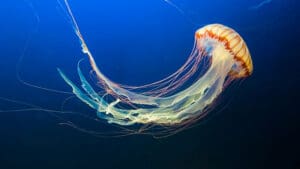How can animals like starfish and jellyfish survive and thrive without brains?
 Well, if you are a regular reader of my columns, you’ve probably figured out by now that I have an inquiring mind. This time, I used it to investigate whether animals, besides mammals, fish, and birds, use typical brain power to learn and function. I always presumed there must be some type of brain or at least a co-ordinating mechanism within every animal to allow it to breathe, move, reproduce, eat, etc.
Well, if you are a regular reader of my columns, you’ve probably figured out by now that I have an inquiring mind. This time, I used it to investigate whether animals, besides mammals, fish, and birds, use typical brain power to learn and function. I always presumed there must be some type of brain or at least a co-ordinating mechanism within every animal to allow it to breathe, move, reproduce, eat, etc.
It looks like I was correct, but I have also learned that many animals don’t have the same central brain system that we have. In fact, several animals don’t have a brain at all!
As it turns out, many of these organisms are marine creatures, and quite a few are sedentary. They spend their entire lives attached to rocks or coral reefs. Instead of central brains, these animals have sensitive tentacles, ganglia, and modified decentralized nervous systems.
 Starfish |
 Sea cucumber |
 Sea sponges |
 Jellyfish |
 Coral |
Starfish lack both brains and hearts, yet they are capable of reproduction, hunting, and waste excretion. Instead of a central brain, they have a nervous plexus, essentially a network of intersecting nerves regulating various bodily functions like respiration and circulation. Essentially, the centralized brain we possess is substituted in the starfish by numerous mini-brains scattered throughout its body. Similarly, comb jellies lack hearts, brains, or a dedicated system for waste excretion, relying instead on a decentralized nerve-based system to manage these functions.
Sea cucumbers use a different mechanism to survive. At the end of each tentacle and in their throat, they have various nerve endings that allow them to send and receive stimuli based on it’s needs. Interestingly, since they, too, don’t have hearts, they rely on a vascular system that transports water, potassium and proteins throughout the body to ensure they survive.
Sponges go one step further as they utilize totipotent cells, which are essentially undifferentiated embryonic cells that have the potential to develop into any type of cell. This means the animal can adapt virtually any of its cells to perform essential bodily functions. As a result, sponges do not require specific organs or a defined nervous system since all their vital activity is performed at the cellular level.
Jellyfish have neither brains nor nervous systems, so they rely on what seems to be a random distribution of individual nerves that are interconnected. In actuality, this system effectively takes touch and light stimuli the animal receives and converts those into life-sustaining responses. Although a Portuguese man-of-war looks like a jellyfish (which is a single organism), it is, in fact, a large colony of individual animals called hydrozoans, each of which provides essential functions that keep the entire colony alive.
Although corals look like tiny plants, they are animals as well! A vast array of individual organisms lives as a single colony that functions to preserve each individual while keeping the colony intact. Their means of survival is again slightly different as they don’t have hearts, brains or a nervous system, which are replaced by a network of polyps with small appendages with sophisticated nerve endings. These allow the individuals to catch prey and perform necessary life-sustaining functions.
Most land-based animals have a brain and organs to keep them alive, but earthworms don’t. In fact, an earthworm essentially only has a mouth, anus, and muscles encased in a pliable exoskeleton. Instead of a brain, they rely on sensory stimuli, such as vibrations, to detect threats. Leeches also don’t have a brain but do have neural networks that are distributed throughout the body, as in several marine organisms.
So there you have it. Nature is so incredibly complex and ensures the survival of individual orgasms through many diverse mechanisms, not just one, as many might presume.
While we’re on the subject – does a large brain make you smarter, and does having no brain make you less intelligent? Apparently not, as the size of the brain has nothing to do with intelligence. Each of its components facilitates learning and memory. Even tiny organisms with no brains at all can learn to find food and avoid predators.
Geoff Carpentier is a published author, expedition guide and environmental consultant.
For interview requests, click here.
The opinions expressed by our columnists and contributors are theirs alone and do not inherently or expressly reflect the views of our publication.
© Troy Media
Troy Media is an editorial content provider to media outlets and its own hosted community news outlets across Canada.


